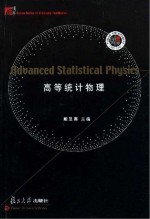图书介绍
高等统计物理pdf电子书版本下载

- 戴显熹编著 著
- 出版社: 上海:复旦大学出版社
- ISBN:7309054881
- 出版时间:2007
- 标注页数:332页
- 文件大小:42MB
- 文件页数:346页
- 主题词:统计物理学
PDF下载
下载说明
高等统计物理PDF格式电子书版下载
下载的文件为RAR压缩包。需要使用解压软件进行解压得到PDF格式图书。建议使用BT下载工具Free Download Manager进行下载,简称FDM(免费,没有广告,支持多平台)。本站资源全部打包为BT种子。所以需要使用专业的BT下载软件进行下载。如 BitComet qBittorrent uTorrent等BT下载工具。迅雷目前由于本站不是热门资源。不推荐使用!后期资源热门了。安装了迅雷也可以迅雷进行下载!
(文件页数 要大于 标注页数,上中下等多册电子书除外)
注意:本站所有压缩包均有解压码: 点击下载压缩包解压工具
图书目录
Chapter 1 Fundamental Principles 1
1.1 Introduction: The Characters of Thermodynamics and Sta-tistical Physics and Their Relationship 1
1.2 Basic Thermodynamic Identities 3
1.3 Fundamental Principles and Conclusions of Classical Sta-tistics 7
1.3.1 Microscopic and Macroscopic Descriptions, Statistical Distribution Functions 8
1.3.2 Liouville Theorem 10
1.3.3 Statistical Independence 13
1.3.4 Microscopical Canonical , Canonical and Grand Ca-nonical Ensembles 14
1.4 Boltzmann Gas 16
1.5 Density Matrix 19
1.5.1Density Matrix 20
1.5.2 Some General Properties of the Density Matrix 22
1.6 Liouville Theorem in Quantum Statistics 25
1.7 Canonical Ensemble 29
1.8 Grand Canonical Ensemble 33
1.8.1 Fundamental Expression of the Grand Canonical En-semble 33
1.8.2 Derivation of the Fundamental Thermodynamic Identity 34
1.9 Probability Distribution and Slater Sum 36
1.9.1Meaning of the Diagonal Elements of the Density Ma-trix 36
1.9.2 Slater Summation 37
1.9.3 Example: Probability of the Harmonic Ensemble 39
1.10 Theory of the Reduced Density Matrix 44
Chapter 2 The Perfect Gas in Quantum Statistics 55
2.1Indistinguishability Principle for Identical Particles 55
2.2 Bose Distribution and Fermi Distribution 60
2.2.1Perfect Gases in Quantum Statistics 60
2.2.2 Bose Distribution 61
2.2.3 Fermi Distribution 62
2.2.4 Comparison of Three Distributions; Gibbs Paradox Again 62
2.3 Density of States, Chemical Potential and Equation of State 65
2.3.1Density of States 65
2.3.2 Virial Equation for Quantum Ideal Gases 66
2.4 Black-body Radiation 69
2.4.1Thermodynamic Quantities for the Black-body Radia-tion Field 71
2.4.2 Exitance and Variety of Displacement Laws 72
2.4.3 Waveband Radiant Exitance and Waveband Photon Exitance 75
2.5 Bose-Einstein Condensation in Bulk 79
2.5.1Bose Condensation, Dynamical Quantities with Tem-perature Lower Than the λ Point 79
2.5.2 Discontinuity of the Derivatives of Specific Heat and λ Phenomena 82
2.5.3 Two-Fluid Theory 85
2.5.4 2-D Case 86
2.6 Degenerate Fermi Gases and Fermi Sphere 87
2.6.1 Properties of Fermi Gases at Absolute Zero 87
2.6.2 Specific Heat of Free Electron Gases 89
2.6.3 State Equation, Heat Capacity at Constant Pressure,and Heavy Fermions 93
2.7 Fermi Integrals and their Low Temperature Expansion 95
2.8 Magnetism of Fermi Gases 97
2.8.1 Spin Magnetism: Paramagnetism 98
2.8.2 Energy Spectra and Stationary States of Electrons in a Homogeneous Magnetic Field 100
2.8.3 Diamagnetism of Orbital Motion of Free Electrons 103
2.9 Peierls Perturbation Expansion of Free Energy 106
2.9.1 Classical Case 107
2.9.2 Quantum Case 108
2.9.3 Expansion of Free Energy of an Ideal Gas in an Exter-nal Field 110
2.10 Appendix 114
Chapter 3 Second Quantization and Model Hamiltonians 117
3.1 Necessity of Second Quantization 117
3.2 Second Quantization for Bose System 119
3.3 Second Quantization ·Fermi System 128
3.4 Some Conservation Laws 135
3.5 Some Model Hamiltonians 140
3.6 Electron Gases with Coulomb Interaction 145
3.6.1 Completely Ionized Gases — the High Temperature Plasma 146
3.6.2 The Degenerate Electron Gas with Coulomb Interac-tion (Metal Plasma) 150
3.7 Anderson Model 167
Chapter 4 Least Action Principle, Field Quantization and the Electron-Phonon System 169
4.1 Classical Description of Lattice Vibrations 169
4.2 Continuous Media Model of Lattice Vibration (Classical) 174
4.3 The Least Action Principle, Euler-Lagrange Equation and Hamilton Equation 177
4.4 Lagrangian and Hamiltonian of Continuous Media 188
4.5 Quantization of the Lattice Vibration Field 191
4.6 Debye Theory of Specific Heat of Solids 197
4.7 The Electron-Phonon System and the Frohlich Hamiltonian 203
Chapter 5 Bose-Einstein Condensation 208
5.1 Spatial and Momentum Distributions of Bose-Einstein Con-densation in Harmonic Traps and Bloch Summation 208
5.1.1 Introduction 208
5.1.2 Generalized Expression for Particle Density 209
5.1.3 Distributions for Ideal Systems 211
5.1.4 New Expression with Clear Physical Picture 212
5.1.5 Momentum Distributions 215
5.1.6 Results of Numerical Calculations 216
5.1.7 Discussion and Concluding Remarks 216
5.1.8 Momentum Distribution of BEC 219
5.2 BEC in Confined Geometry and Thermodynamic Mapping 220
5.2.1 Introduction 220
5.2.2 Confinement Effects 222
5.2.3 Thermodynamic Mapping 222
5.2.4 Mapping Relation for Confined BEC 225
5.2.5 Determination of the Critical Temperature 229
5.2.6 Discussion 233
Chapter 6 Some Inverse Problems in Quantum Statistics 235
6.1 Introduction 235
6.2 Specific Heat-Phonon Spectrum Inversion 237
6.2.1 Technique for Eliminating Divergences 239
6.2.2 Unique Existence Theorem and Exact SPIE Solution 241
6.2.3 Summary 242
6.3 Concrete Realization of Inversion 244
6.3.1 The Specific Heat-Phonon Spectrum Inversion Problem 244
6.3.2 Results and Concluding Remarks 250
6.4 Mobius Inversion Formula 252
6.4.1 Riemann ξ Function and Mobius Function 252
6.4.2 Mobius Inversion Formula 253
6.4.3 The Modified Mobius Inversion Formula 255
6.4.4 Applications in Physics 256
6.5 Unification of the Theories 258
6.5.1 Introduction 258
6.5.2 Deriving Chen’s Formula from Dai’s Exact Solution 259
6.5.3 Concluding Remarks 262
6.6 Appendix 263
Chapter 7 An Introduction to Theory of Green’s Func-tions 265
7.1 Temperature -Time Green’s Functions 265
7.1.1 Definition of Temperature -Time Green’s Functions 265
7.1.2 The Equation of Motion of Double-Time Green’s Functions 269
7.1.3 Time Correlation Functions 270
7.2 Spectral Theorem 272
7.2.1 Spectral Representation of Time Correlation Functions 272
7.2.2 Spectral Representations of Retarded and Advanced Green’s Functions 274
7.2.3 Spectral Representation of Causal Green’s Functions 278
7.3 Example: Ideal Quantum Gases 279
7.4 Theory of Superconductivity with Double-Time Green’s Functions 283
7.5 Higher-Order Spectral Theorem, Sum Rules and Unique-ness 290
Chapter 8 A Unified Diagonalization Theorem for Quad-ratic Hamiltonian 291
8.1 A Model Hamiltonian 293
8.2 Diagonalization Theorem for Fermi Quadratic Forms 296
8.3 Conclusion: A Unified Diagonalization Theorem 305
Chapter 9 Functional Integral Approach: A Third Formu-lation of Quantum Statistical Mechanics 308
9.1 Introduction 308
9.1.1 Hubbard’s Method 309
9.1.2 Difficulties 310
9.2 An Operator Identity 311
9.3 Functional Integral Formulation of Quantum Statistical Me-chanics 311
9.4 Reality and Method of Steepest Descents 314
9.5 Discussion and Concluding Remarks 318
9.6 Some Recent Developments 318
9.7 Application: An Exact Solution 319
References 324
Index 330